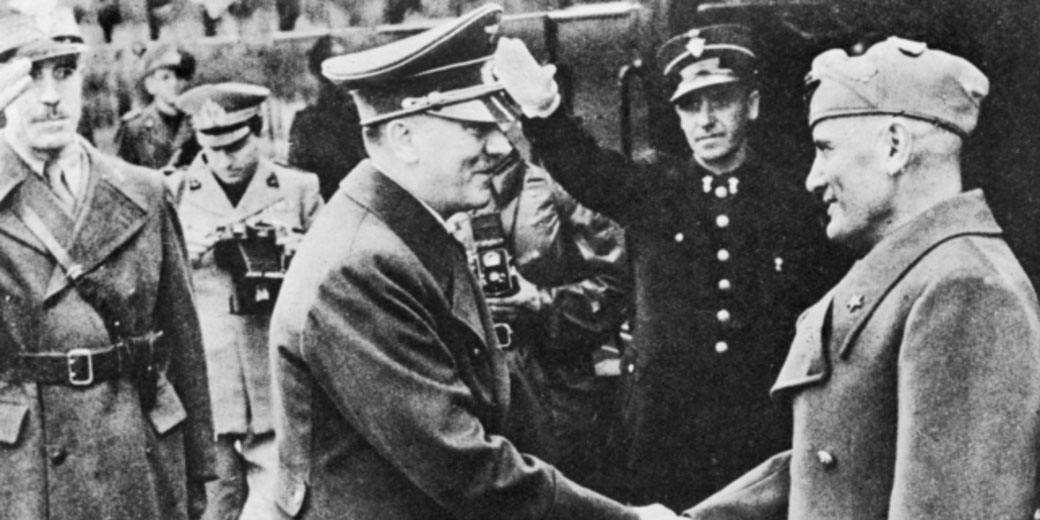Who were the Axis Powers in WWII?

The Axis Powers in the Second World War formed a military and political alliance that broke the post-World War I order, and they helped start the deadliest war in human history.
As they gained more power, they set out to divide the world into zones they could control, but the fact that they never worked well together ultimately undermined their effectiveness.
The three Axis Powers explained
Germany, Italy, and Japan formalised their agreement in stages. Firstly, the Anti-Comintern Pact of 1936 set out their shared opposition to communism and, in 1939, the Pact of Steel made the German and Italian military partnership official.
Meanwhile, the Tripartite Pact of 1940, which they signed in Berlin, defined how they would share control of territory.
Under the Tripartite Pact, the three nations pledged to help one another if any of them were attacked by a country not already at war with one of the others.
They planned campaigns independently, however, and they rarely fought together in large operations.
Their cooperation arose from chance and timing rather than from a genuine shared strategy.
This meant, that from the start, each nation had its own aims. Germany set out to conquer Eastern Europe and to end communism, while Italy aimed to gain land in Africa and the Balkans.
In contratst, Japan wanted oil and rubber, and it intended to push Western powers out of Asia.
This division meant they fought on separate fronts against different enemies.
Nazi Germany
Germany was at the centre of the Axis coalition. Hitler became chancellor in January 1933, and he took full control after President Hindenburg died in 1934.
He built a powerful central government, he broke international limits on armaments, and he pursued a foreign policy based on racism and hate.
In 1936, German troops reoccupied the Rhineland. Two years later, Hitler united Germany with Austria, and then he took the Sudetenland after the Munich Conference.
Early in 1939, he seized the rest of Czechoslovakia without facing serious opposition.
Later that year, he signed a non-aggression pact with the Soviet Union, which included a secret protocol to divide Eastern Europe.
Fascist Italy
Italy, which Benito Mussolini led, became the first European nation to embrace one-party rule.
Mussolini took power in 1922 after the March on Rome, and he then dismantled democratic institutions.
He argued that fascism would unite the country, he aimed to strengthen the economy, and he sought to build a new empire.
In 1935, Italy invaded Ethiopia. While other nations protested, Italy completed the conquest and declared Ethiopia a colony.
Then, fighting in Spain in the late 1930s strengthened ties between Italy and Germany.
In 1939, Italy and Germany signed the Pact of Steel to promise mutual military support.
Imperial Japan
Japan entered the Axis alliance with long-held plans for regional expansion. Since the late nineteenth century, Japan had pursued empire-building through victories in the First Sino-Japanese War and the Russo-Japanese War.
By the 1930s, Japanese military leaders gained more influence over the civilian government, especially after the assassination of Prime Minister Inukai Tsuyoshi in 1932.
They advocated for conquest in China and Southeast Asia as a means of national security and standing.
In 1931, Japanese forces occupied Manchuria and set up the Manchukuo government.
In 1937, the Marco Polo Bridge Incident led to a full-scale war with China.
As such, Japanese troops quickly captured key cities, including Nanjing, where they carried out a massacre of civilians and prisoners that shocked international observers.
Known as the Nanjing Massacre, it resulted in the deaths of an estimated 200,000 to 300,000 people, though some modern estimates suggest a lower range around 100,000.
Despite early advances, the Chinese Nationalists and Communists continued to resist occupation.
In 1940, Japan signed the Tripartite Pact and prepared for war against Western powers.
Tensions increased when the United States, Britain, and the Netherlands imposed embargoes on oil and other strategic materials.
Seeking to secure resources and eliminate potential threats, Japanese leaders approved a coordinated strike plan.
What happened to the Axis Powers?
As early as 1943, the Axis alliance began to collapse under constant military attacks.
Italy fell first, and its former leader Mussolini was executed in April 1945. In the Soviet Union, German armies suffered major losses at Stalingrad and Kursk.
In Western Europe, the D-Day landings of June 1944 allowed Allied forces to free France and advance toward Germany.
By March 1945, Soviet and Western armies were closing in on Berlin.
On 30 April 1945, Hitler killed himself in his underground bunker, leaving the German High Command to sign an unconditional surrender on 7 May, and the ceasefire took effect the following day, known as Victory in Europe Day.
Japan continued to resist, but its position worsened quickly as American forces advanced across the Pacific and bombed urban centres.
Following the atomic attacks on Hiroshima and Nagasaki and the Soviet invasion of Manchuria under Operation August Storm, Japan announced its surrender.
On 2 September 1945, the official ceremony happened on board the USS Missouri in Tokyo Bay. With the surrender of Japan, the Axis Powers ceased to exist.
What do you need help with?
Download ready-to-use digital learning resources
Copyright © History Skills 2014-2025.
Contact via email
With the exception of links to external sites, some historical sources and extracts from specific publications, all content on this website is copyrighted by History Skills. This content may not be copied, republished or redistributed without written permission from the website creator. Please use the Contact page to obtain relevant permission.





